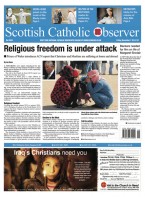August 15 | ![]() 0 COMMENTS
0 COMMENTS ![]() print
print

Eilean Ban – Scotland and Britain’s first seminary
Ian Forbes from Blairs Museum writes on the 300th anniversary of the opening of Eilean Ban— the first seminary on Scottish soil—and on Scotland’s junior seminaries
Eilean Ban is not perhaps a place known to many people—it is a small island on Loch Morar on the west coast of Scotland near Mallaig. In 1714 the island’s relative isolation—removed from worldly distractions— made it an ideal location for a seminary. Equally important, given the religious and political unrest at the time, Eilean Ban was in Catholic Clanranald— affording some protection at a time when Catholic schools in Scotland had been illegal for 150 years and would remain so for another 80 years. Eilean Ban was the first seminary to be founded anywhere in the British Isles—Scotland, England, Wales or Ireland.
As a response to The Reformation the Church instituted the Council of Trent with the Council of bishops meeting 3 times between 1545 and 1563. One of its central decrees was to institute seminaries. Seminaries were to be opened to train boys:
‘At least twelve years old, born in lawful wedlock, and who know how to read and write competently, and whose character and inclination afford a hope that they will always serve in the ecclesiastical ministry.’
The Council decree further specified ‘that the children of the poor be principally selected.’ The Council of Trent’s aim was the establishment of both junior and senior seminaries. In Scotland, due to circumstances – religious and political, this did not happen.
Indeed, conditions in Scotland at the time did not support the opening of any seminaries. In 1560 the Scottish Parliament had declared Scotland to be Protestant and outlawed the Catholic religion.Therefore, seminaries to educate Scottish priests were established in several European countries. Mary, Queen of Scots, despite her then imprisonment, gave encouragement and financial support—in particular to the Scots College at Douai, northern France. There is also some evidence of ‘schools’ in Scotland whereby boys lived and studied in the home of a priest—a school of this type is recorded in Glenlivet in 1699, but the priest then moved, the school closed. It is difficult to establish the full history of seminaries in Scotland. Written records are scarce and often in code—to avoid incriminating evidence. However, it is known that in 1695 the Church in Scotland was provided with a leader, a missionary bishop—the first Vicar Apostolic for Scotland, Thomas Nicholson.
Prompted by the small numbers of priests coming to and remaining in Scotland from the colleges on the continent, the goal of Bishop James Gordon, Bishop Nicholson’s co-adjutor, was for a seminary in Scotland. In the summer of 1714 seven boys commenced their studies on Eilean Ban (the ‘White Island’, the name derived from its white sands). Their tutor was a dedicated young priest from the Scots College in Paris, Father George Innes. The Eilean Ban buildings had walls of turf, an earth floor and a smoke-hole in their heather thatch roof. In 1964 the outlines of three buildings and a fairly large garden were discovered – one building of about 40 by 15 feet, and the other two each about 15 by 9 feet. Student numbers increased quickly, and in 1715 two Eilean Ban students were sent to Rome: Allan Macdonald (age 19) and John Maclachlan (age 23). Another Eilean Ban student, Hugh Macdonald, son of the Laird of Morar, was one of the first ‘heather priests’ (trained entirely in Scotland) and was later ordained bishop.
The first national seminary in Scotland at Eilean Ban was to be short lived. The failure of the 1715 Rebellion—only one year after its opening, forced George Innes and his students to abandon the seminary. By June 1716 George was in hiding in Glenlivet— with at least some of his students. Later that same year Scalan in Glenlivet became the national seminary. In 1727 Church organisation in Scotland was divided between the Highland and Lowland Districts, the divide running roughly between Inverness and Helensburgh. Perhaps more pertinently, the line divided Scotland into Gaelic and Scots speaking areas.
Bishop Hugh Macdonald re-opened Eilean Ban as the Highland District seminary in 1732, but it again closed in 1738. Other seminaries followed, but all experienced difficulties in becoming established: Guidal, Arisaig 1738-1746; Bourblach, Morar 1746-1762 & 1770-1783; Glenfinnan, Loch Shiel 1762-1770; Samalaman, Glenuig 1783-1803; Kilcheran, Lismore 1803-1828. In contrast, the Lowland District seminary was more securely established. Scalan continued, albeit with some interruptions, until 1799. On which date, as a result of The Relief Bill 1793 (which had restored some rights to Catholics) it moved to Aquhorties, Inverurie.
In 1829 John Menzies of Pitfodels generously endowed the establishment of a new national seminary at Blairs College, Aberdeen, enabling the merger of the Lismore and Aquhorties seminaries. Between 1961 and 1978 Blairs, now the national junior seminary, was full to capacity and so Saint Vincent’s College, Langbank was opened for S1 & S2 students. 300 junior seminarians were, then, being educated annually in Scotland—an astonishing achievement from those first 7 students at Eilean Ban. By 1986 however, changed social and Church circumstances and priorities brought about the closure of Blairs—the last in a celebrated historic line of Scottish national seminaries.
—Blairs Museum, the museum of Scotland’s Catholic Heritage, occupies the former sacristy of Blairs College. It contains a collection of items given to Blairs College, the most famous of which is the Blairs Memorial Portrait of Mary, Queen of Scots. Currently Blairs Museum has a small exhibition celebrating the tercentenary of Scotland’s junior seminaries. A set of vestments given to Blairs College by Pope Paul VI to celebrate the 250th anniversary of Eilean Ban in 1964 is part of the exhibition.
Pic: Bishop Joseph Toal and Bishop Hugh Gilbert help with the tree planting at Our Lady of Perpetual Succour and St Cummin near Loch Morar after the 300th anniversary Mass celebration on August 6











